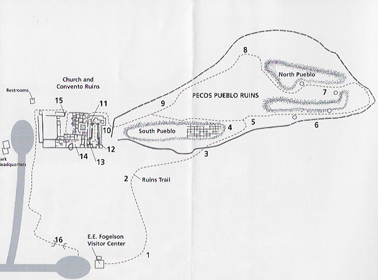
On trail after the kiva #6 (N35D33'08.442 X W105D41'23.790)
Flowers first observed: 9/22/17
The Bush w/Flowers

The Flowers
Distribution
"Found on dry rocky hillsides, often in shaded forests or in canyons, from 4,000-10,000 ft (1219-3048 m); flowers July-October. Distribution: Western US, from WA to MT, south to CA, AZ, NM, TX, and AR. (SEINet)
Description
"Perennial herb, 30-95 cm tall, from a woody caudex and usually thickened taproot; stems branched and puberulent. Leaves: Opposite or alternate, on petioles 1-7 cm long; blades 3-nerved from bases, triangular, deltate-ovate, or lance-ovate, 1.5-12 cm long by 2-7 cm wide, bases acute, truncate or subcordate, apices attenuate, margins crenate, dentate, or serrate, faces puberulent and gland-dotted. Flowers: Flower heads discoid, often nodding, arranged in loose panicles, the peduncles 4-30 mm long, pubescent; involucre (ring of bracts wrapped around the flower head) cylindric or obconic, 7-12 mm high, the bracts (phyllaries) 30-40 in 5-7 series, greenish, 4-5 striate, unequal, with scarious margins; florets 20-40, all discs, the corollas pale yellow-green, 7 mm long. Fruits: Achenes 4-5 mm, hispidulous to hirtellous, topped with a pappus of 20-30 white, barbellate bristles. Ecology: Found on dry rocky hillsides, often in shaded forests or in canyons, from 4,000-10,000 ft (1219-3048 m); flowers July-October." ---Notes: Brickellia is a genus of shrubs and perennial herbs with all disc flowers, these usually white to cream colored; flower heads wrapped in several rows of bracts (phyllaries), the outer rows shorter than the inner rows; and 10-nerved seeds topped with white tufts of bristles. B. grandiflora is distinguished from other Brickellia by its stems that branch all along their length; the long, slender petioles bearing distinctively triangular leaves with tidy round teeth on the margins and long-pointed tips; and the loose clusters of flowers that nod or dangle like tassels at the ends of the branches. Resembles B. floribunda but that the leaves of that species are more of a slightly rounded triangle shape, and lack the long-attenuate pointed tip; and the flower heads do not usually dangle.(SEINet)
Ethnobotanical Uses
"Leaves used medicinally as an antirheumatic, a liver medicine, to treat flatulence, overeating, headaches, and influenza; the seeds are said to be poisonous by one tribe and eaten as a grain by another tribe; the plant is used ceremonally; and the branches used to make brooms." (SEINet)
Internet Links